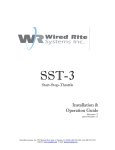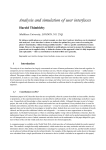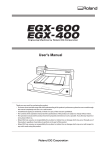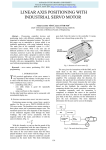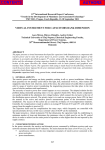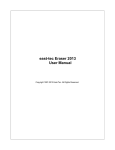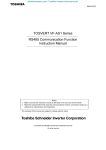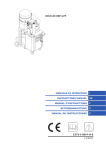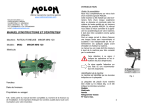Download state of the art of the automatic control and monitoring system from
Transcript
Proceedings World Geothermal Congress 2000 Kyushu - Tohoku, Japan, May 28 - June 10, 2000 STATE OF THE ART OF THE AUTOMATIC CONTROL AND MONITORING SYSTEM FROM THE GEOTHERMAL PLANT FROM THE UNIVERSITY OF ORADEA, ROMANIA: PRESENT AND PERSPECTIVES 1 Doina Zmaranda1, Gianina Gabor 2 University of Oradea, 5 Armatei Romane St., 3700 Oradea, Romania University of Oradea, 5 Armatei Romane St., 3700 Oradea, Romania 2 Key Words: control system, Programmable Logic Controller (PLC), user interface configuration was established, based on the application requirements (Philips96). From the hardware point of view, the following devices were used: • an Allen Bradley PLC SLC-5/03 (Programmable Logic Controller) equipped with multiple I/O modules and a non-interruptible power supply for developing the control program (Rockwell94); the scan time for this PLC is 1ms/Kword of program and 0.225 ms for the I/O • an ordinary PC computer (Pentium 133 MHz) for developing the graphical user interface; in order to minimize the control program as much as possible, some calculations are also done here; also, all data used for historical trends are stored on the computer hard disk • an Allen Bradley DTAM Micro module for developing a text user interface (Rockwell95); this is used only if the graphical one breaks down ABSTRACT In its first part, the paper intends to describe the main features of the already implemented automatic control and monitoring system from the University of Oradea, from the implementation point of view including aspects regarding the software and hardware. In the second part of the paper some future perspectives of this existing system will be outlined. Between these, there are some important directions in which we already start to work on. First, there are the modifications that we have done to the implemented system: these result after a period of almost two years of continuously running the system. Because the system is at this moment, unique in our country, another aspect regarding the future perspectives deals with the way in which it is used for training students from our university. However the system described in the paper turns the attention to tools and techniques that help us building such complex systems in a safe and secure way. From the software point of view, it results from the requirements analysis that the control program must perform the following operations: • monitoring and controlling different parameters: flows, pressures, temperatures, levels, and so on, using different actuators: motors, valves, switches • handling the alarms • re-starting and stopping the system • changing between different operation modes: automatic, manually, etc. • other specific functions 1. INTRODUCTION The automatic control and monitoring system for the geothermal plant from the University of Oradea was already described from the structural and functional point of view in (Zmaranda95). The Advanced Programming Software (APS) from Allen Bradley was used in developing the control program (Rockwell95). APS is a dedicated software environment for industrial control. The resulting program is of type “ladder logic” and was developed using an IBM-PC compatible computer and then downloaded into the PLC. 1.1. The system structure The controlled plant is composed of 3 parts: the well station, the pump station and the heat station. The system functions in the following way: • the geothermal water is extracted from the well station using a deep well pump if the necessary flowrate is greater than the artesian one; • the water is then stored into a reservoir tank, which acts as an accumulator and also separates the production network from the distribution network; • from the reservoir tank the water is pumped, through the pump station to the heat station; For the user interface development the InTouch SCADA package on a PC is used (Wonderware94). The display windows that formed the user interface are linked with the PLC using Dynamic Data Exchange (DDE) communication protocol in order to transfer data (Wonderware90). 2. MODIFICATIONS TO THE EXISTING SYSTEM In the heat station, the water is not directly utilised, but through 4 heat exchangers; the water that comes out from these heat exchangers flows into the distribution network and heats the university campus buildings. In order to obtain a better functionality of the system, several modification were done to the initial implemented control system. The main goal of these modifications is to obtain a better performance of the system as well as a higher reliability than in the previous version. 1.2. The control system structure In order to implement the automatic system for this geothermal plant, the general hardware and software 4099 a suitable number of cyclic periods and apply interpolation in the presence of a fault in order to approximate a missing measurement. These series may also be continually calculated and applied for determining the reasonability of measurements over time. 2.1. Improving the reliability and predictability of the software program by using the cyclic approach One of the simplest ways of developing automatic and control systems is using the cyclic approach. In the latest years there has been a lack of research in respect to exploiting the cyclic approach in automatic control systems. This is mainly due to the fact that the simplifying fundamental properties seemingly do not provide significant academic research challenge. Practical applications prove that this wrong, because up to now, the time-based approach was an essential ingredient in reducing the complexity and achieving mapping simplifications in the form of bulk synchronous processing. The cyclic approach views the modules like subroutines of a main program. Consequently, the program structure should be based upon the partitioning of application into modules depending on functionality (and, when necessary, on time constrains) that are coupled together using a control structure. A general structure is presented below. This partitioning leads to a set of operations, each operation performing a specific function. The cyclic approach paradigm is based on a philosophy of resource adequacy; that is, it relies upon the assumption that there are sufficient resources to guarantee that all processing requirements are met on time (Kopetz92). If processing resources are not sufficient to accomplish all processing, there are two means of achieving resource adequacy: employing faster processing elements or paralleling and distributing functions to multiple processing elements (nodes). DO forever DO during deltaT CASE mode1: WITH sensors AND actuators DO [EVERY Nth deltaT ] BEGIN operation1();operation2(); .... IF situation_predicate THEN .... operationi();operationj(); .... IF situation_predicate THEN .... operationk();operationm(); ... ..... END mode2: WITH sensors AND actuators DO [EVERY Nth deltaT ] BEGIN operationp();operationq(); .... IF situation_predicate THEN .... operationr();operationv();.... ..... END ........ startup_mode: WITH sensors AND actuators DO [EVERY Nth deltaT ] BEGIN ..... END ENDCASE Given this paradigm, the programmed application logic could be divided into short code segments, each of these parts having a uniform structure and a pre-defined functionality (Figure 1). The most essential timing property is deltaT, which is the interval, which establish cyclic execution frequency. The value of deltaT must be established on a rational applicationdependent basis. This is the central issue in constructing automatic control systems upon a cyclic approach, so each particular application requires proper engineering risk and trade-off analysis in order to determine the appropriate execution frequency properties. Two contradictory requirements must be accomplished when establishing the value for deltaT: first, the deltaT parameter must be long enough to permit all processing to be accomplished and second, the deltaT parameter must be sufficiently short to insure stability of the system, so every critical situation can be properly handled. Usually, a trigger task is used to regularly capture the state of the environment. This trigger task is a periodic task that evaluates a trigger condition on a set of temporally accurate real-time variables. The result of a trigger task can be a control signal that activates another application task (Kopetz92). Since data, either external or internal, is sampled at the frequency of the trigger task, only those data with duration greater than the sampling period of the trigger task deltaT are guaranteed to be observed. A strong advantage of applying a solution based upon timing intervals is the possibility to treat hardware and software faults in a reasonable manner. This advantage accrues due to having simultaneous control over the continuous processing being done and the rate at which it is being performed. Using the cyclic approach, a fault may only have local time effects, but the system will automatically stabilize itself in succeeding time periods. It is obvious that the basic structure of the software presented above corresponds to the fundamental cyclic paradigm presented in Figure 1. This approach also provides a strong mechanism for focusing upon the essential issues of the specific application domain. This cyclic approach was used for developing the control program for the geothermal plant from the University of Oradea. The control program implemented into the PLC runs forever and every module is implemented as a separate subroutine. So, the structure of the program developed with this software corresponds to the general structure presented above. The main advantage of the time-driven approach is that a better error detection and confinement can be achieved (Halang91). Also, for critical measurements, it is also possible to build time-series for 4100 The time base here (deltaT) is the time scan of the controller, and it depends of processor speed as \\\ell as the length of the control program. In order to improve the time scan, the modules (subroutines) were so created in order to minimize the length of the control program; all modules that perform additional calculations were moved, if possible, on the PC computer. the fresh water delivers water for the buildings from our university and for the heat station by intermittent control of the pumps. So the PT8 is varying between 2-4 bars (Figure2). The domestic hot water is produced with constant supply temperature TT12, with the aid of the controller RG7. The RG7 controller utilizes the control valve CV3 to regulate the flow of the geothermal water to the DHW heat exchanger to heat up the DHW water to the supply temperature, TT12. The controller RG8 utilizes the control valve CV5 to regulate the pressure inlet to the DHW heat exchanger. The on/off control valve CV6 is used to protect the plate heat exchanger from excessive differential pressure across the plates due to the excessive fresh water supply system, PT8. In its current version, the control program consists of 29 program files (modules), 92 data files, 6828 instructions and uses approximately 200 I/O signals. The scan time obtained with this program were approximately 100ms, which includes program time scan, I/O time scan and actuators delays as well as the trigger-task overhead. This corresponds to the application needs: the controlling and monitoring system for the Oradea University Geothermal Plant is a relatively slow real-time control system and consequently all time constants imposed are of the order of magnitude of one ore more minutes (Zmaranda95), so that a scan time period of approximately 100ms means that it could be a maximum delay in treating an exceptional situation of 200ms, which is more than acceptable. It can be observed that the number of modules is relatively big, but only 25% of the modules deal with normal functioning of the system. The rest of them (75%) are dealing with handling exceptional situation, such as alarms for example, which rarely appear. This protection, although increasing the program length, was necessary for obtaining robust software (Parr95). Together with a group of specialists from the University of Oradea we analyzed the system control automation (Figure2) and we realized that the behavior of the controllers RG5-RG6 depends on the behavior of RG7-RG8 controllers. In this case the valves CV4 and CV5 are working (opening and closing) very often to keep the temperatures to the preset values. To eliminate this inconvenient we proposed another strategy presented in Figure 3. By introducing a pressure controller in the DHW we obtained all the new possible control loops. Table 1 presents all the possible cases for winter and summer. In order to simulate the new strategy, we created a model using equations from both dynamically and statically cases, considering also the initial conditions (MGA96). So the equations characterizing the statically regime of the heat station are (Popa86): 2.2. Improving the control strategy for the heat station The heat station’s function is to heat up the buildings (DHdistrict heating) of the University and to supply them with domestic hot water (DHW). These processes are operated indirectly; i.e. the geothermal water is used indirectly in plate exchangers to supply heat energy. The return geothermal water from the heating processes leaves the station in a common pipe and is discharged in the river Peta or to cascaded users. Q 1 ⋅ c ⋅ ( t 1in − t 1ies ) = Q s 1 ⋅ c ⋅ ( t s 1ies − t s 1in ) = K1 ⋅S1 ⋅ ( t 1in − t s1ies ) + ( t 1ies − t s 1in ) 2 Q2 ⋅ c ⋅ (t2in − t2ies) = Qs2 ⋅ c ⋅ (ts2ies − ts2in) = K2 ⋅ S2 ⋅ The DH (district heating) network is a closed system, directly connected to the elements in the buildings and heated indirectly by geothermal water in four plate exchangers. The heating period has an average of 172 days/year and in summer time the distribution network is emptied. Two of the three circulation pumps P 5-7 are used to circulate water in the closed DH network to deliver heat to the buildings. Two make-up water pumps P8-9 are used to ad water into the closed DH network to maintain its static pressure within predetermined limits to compensate it for leakage. (t2in − ts2ies) + (t2ies − ts2in) 2 Q Q 2 = ka c m 0 = Q Q Q 1 1 0 = kt ⋅ p x − p ⋅ px − pa = k + Q 0 ⋅ p s − p a x 2 where: Q1 – flowrate through the heat exchanger used for DH Q2 – flowrate through the heat exchanger used for DHW Q0 – total flowrate from the well t1in, t1ies – input/output temperature for the heat exchanger used for DH t2in, t2ies – input/output temperature for the heat exchanger used for DHW K1, K2 – global coefficients for the heat exchange in the heat exchangers S1, S2 – surfaces for the heat exchange k0, kt, kacm – flow coefficients for valves CV0, CV5, CV4 px – pressure to be maintained (corresponds to PT1) pa – atmospheric pressure ps – well pressure Controller RG5 is used to control the supply temperature, TT8 for the district heating network (Figure 2). This regulator utilizes the control valve CV2 to regulate the flow of the geothermal water to the DH exchanger to heat the supply water, TT8 in the district heating network. The controller RG6 utilizes CV4 to regulate the pressure inlet to the DH heat exchanger. The function of P8 and P9 is to keep return pressure PT5 (the static pressure in the system). The DHW (domestic hot water) is produced indirectly by heating up cold water from the University’s fresh water supply in a plate heat exchanger with geothermal water. There are two plate exchangers and one is for reserve. The system is operated continuously all year around. The pumping station of 4101 In the mean time the dynamically regime is characterized by the following equations: d dt d dt [Q 2 1 d t d Q0 d t dQ 2 dt 1 ⋅S1 ⋅ ( t 1i n 2 = = = ⋅S2 ⋅ d d [Q s 2 ⋅ c ⋅ ( t s 2 i e s − t s 2 in ) ] = 2 [k [k d t dt dt ( t 2 in − t s 2 i e s ) + ( t 2 i e s − t s 2 in ) d d t d 2 ⋅ c ⋅ ( t 2 in − t 2 i e s ) ] = d K d t d Q The system already implemented is in present intensively used for the teaching purposes. The students study the following issues: • the importance of the geothermal energy and its main directions of utilization • the main possibilities of geothermal energy utilization in our country • the main methods and tools used for automating geothermal plants: creating and implementing simulation programs using ACSL; creating control programs using APS software from Allen Bradley; creating and implementing user interfaces using Wonderware InTouch software; means of optimization of the system functions through control parameters modification d [Q s 1 ⋅ c ⋅ ( t s 1 i e s − t s 1 i n ) ] = dt − t s 1 i e s ) + ( t 1i e s − t s 1i n ) ⋅ c ⋅ ( t 1i n − t 1 i e s ) ] = d K d t = = [Q 1 2.3. Training the students using the implemented control system t ⋅ p x − p a 0 ⋅ p s − p x [k ⋅ a c m p x ] ] − p ] a In order to improve the security of the control system we have the possibility to train the operators using the simulation program. The simulation program gives us the possibility to test the system response without connecting it to the real plant. Different scenarios can be tested and the human response and behavior can be also evaluated. In the future we also intend to create a summer school for training personal to work into the geothermal plants from operator to system engineer level. The simulation language chosen was ACSL/GM – the Graphic Modeller from Advanced Continuous Simulating Language created by MGA Software (MGA95, MGA96). Through simulation we tried to maintain the PT1 pressure around 2 bars, TT8 around 55 oC, and TT12 at around 70 oC , according to the C case from the Table 1. The following equations that are characterizing the heating process from the heat exchangers (Popa86): d ( t1 ) = Q 1 ⋅ c ⋅ d (ts1) = Q r1 = r1 0 t1 = s1 ⋅c ⋅ t1in − t1 m1 ⋅c t s 1i n − t s 1 m Q ⋅ 1 m ax Q1 ∫ d (t 1 ) ⋅c s1 0 ,8 − + (t 1 (t 1 + t 1 i n ) − (t s 1 + t s 1 i n 2 ⋅ r1 ⋅ m 1 ⋅ c + t 1 i n ) − (t s 1 + t s 1 i n 2 ⋅ r1 ⋅ m s 1 ⋅ c Q + s1 m ax Q s1 t s1 = 3. CONCLUSIONS 0 ,8 ∫ d (t s 1 ) In this paper some specific problems associated with the implementation of control systems for geothermal plants were considered. It was demonstrated that the joint goals of predictability and determinism could be achieved using the cyclic paradigm based on resource adequacy. The automatic control and monitoring system for the geothermal plant from the University of Oradea demonstrates that for a wide category of automatic control systems the cyclic approach is a simple but a feasible solution in order to achieve predictability and determinism. ) ) Such a control system needs a permanent maintenance and improvement in order to obtain an optimum functionality. In its second part, this paper tries to present some of the recently modifications done into the system as a result of a two years functioning analysis. Where : t1in, t1 – input/output temperature for primary agent; ts1in, t s1 – input/output temperature for secondary agent; m1, ms1quantity of water from the primary/secondary heat exchanger; Q1, Qs1 - the flow from the primary and secondary agent in the heat exchanger; r1,r10 − global coefficient for the heat exchange; Q1max, Qs1max – maximum flow for fully opened valves in the primary/secondary heat exchanger All the modifications implemented lead to a better system performance but also improve the knowledge about the system behavior. By using this control system in the teaching process, we try to create specialists in this domain that will be able in the future to exploit in the modern way the existing geothermal resources from our country. After the simulation, our new startegy model for the heat station was accepted as a realistic one and with a rational functioning after studying the results obtained. For the considered cases (Table 1), the validation of the proposed model was made with data collected from the real system and the results were as we expected. After the validation of all cases we started to implement our new strategy for the heat station by making changes in the PLC program. These are our mains working issues at present. ACKNOLEDGEMENTS The authors of this paper would like to express their gratitude to all the colleagues from the University of Oradea who participate in the development and maintenance process of the geothermal plant from the University of Oradea. 4102 (Zmaranda95) Zmaranda, D. (1995). Automatic Control and Monitoring System for the District Heating System at the University of Oradea. United Nations University Reports, Reykjavik, Iceland, pp23. Special thanks to all staff members of Orkustofnun, Iceland, especially to Dr. Ingvar Fridleifsson, for their efficient training in geothermal matters. Also to all the staff from Rafhonnun Ltd., were this project initially started. Finally, we want to express our gratitude to Prof. Dr. Ing. Teodor Maghiar, rector of University of Oradea, who created the possibility for this project to exist. (Rockwell94) Rockwell automation (1994). Advanced programming Software. User Manual, Reference Manual, pp567. REFERENCES (Wonderware90) Wonderware Corporation (1990). DDE Sever, Allen Bradley Serial, pp69. (Halang91) Halang W.A., Stoyenko A.D (1991). Constructing Predictable Real-Time Systems. Kluwer Academic Publishers, 254pp. (Wonderware94) Wonderware Corporation (1994). InTouch. User’s Guide, pp489. (Kopetz92) Kopetz H. (1992). Time-Triggered versus Event-Triggered Systems. Proc. International Workshop on Operating Systems in the 90s and Beyond, Vol. 563, pp45-67. (Popa86) Popa, B. (1986) : Thermotechnician Engineer Manual, Editura Tehnica, Bucharest, pp123. (Parr95) Parr, E., A. (1995). Programmable Controllers. An Engineer’s Guide,. Newnes, an imprint of ButterworthHeinemann Ltd. Oxford, pp325. (Philips96) Phillips, C., I., .Harbor, R., D. (1996). Feedback Controlled Systems , Prentice Hall International, pp436. (MGA95) MGA Software (1995): ACSL Reference Manual , Edition 11.1, pp367. (Rockwell95) Rockwell Automation (1995). Allen Bradley Automation Systems, pp345. (MGA96) MGA Software (1996). ACSL Graphic Modeller, Version 4.1, pp124. Table 1. Possible cases for winter and summer Symbol RG8 RG7 RG6 RG8 RG6 RG8 RG6 RG8 Name Final control Process value element (A) SUMMER Supplied water temperature CV5 TT12 Water pressure in the heat exchanger CV3 PT7 (B) WINTER – P1 not functioning and the pumps functioning Water temperature in the secondary circuit CV4 TT8 Supplied water temperature CV5 TT12 (C) WINTER – P1 not functioning and the pumps by-passed Water temperature in the secondary circuit CV4 TT8 Supplied water temperature CV5 TT12 (D) WINTER – P1 and the pumps are not functioning Water temperature in the secondary circuit CV4 TT8 Supplied water temperature CV5 TT12 4103 Preset value 50-55 0C 2-2.5 bar 65-75 0C 50-55 0C 65-75 0C 50-55 0C 65-75 0C 50-55 0C analyze the current situation perform processing actions decide on measures to take actuate measures time deltaT Figure 1. The basic cycle of a control system Legend: TT PT FT RG CV M DH DHW CW TT7 M =temperature transmitter =pressure transmitter =flowrate transmitter =controller =control valve =motor for valve control =district heating =domestic hot water =cold water P8,P9 TT4 TT6 RG5 CV5 CV4 M RG8 FT3 TT6 RG6 TT9 PT4 P5 P6 P7 M FT6 M CV2 FT4 PT7 PT3 CV3 X4 PT6 CV6 X2 CW RG7 TT5 PT8 TT12 DHW DH Figure 2. Schematic diagram for the heat station CW (cold water) DHW (domestic hot water) pressure controller RG11 TT8 Q2 M RG6 PT1 M CV4 Q0 CV0 px Cascade usage/ Peta CV5 t 1ies M t1in well no.4796 RG8 ts1ies Q1 TT12 ts1in DH (district heating) CW (cold water) Figure 3. The simplified model of the new strategy for the heat station 4104









